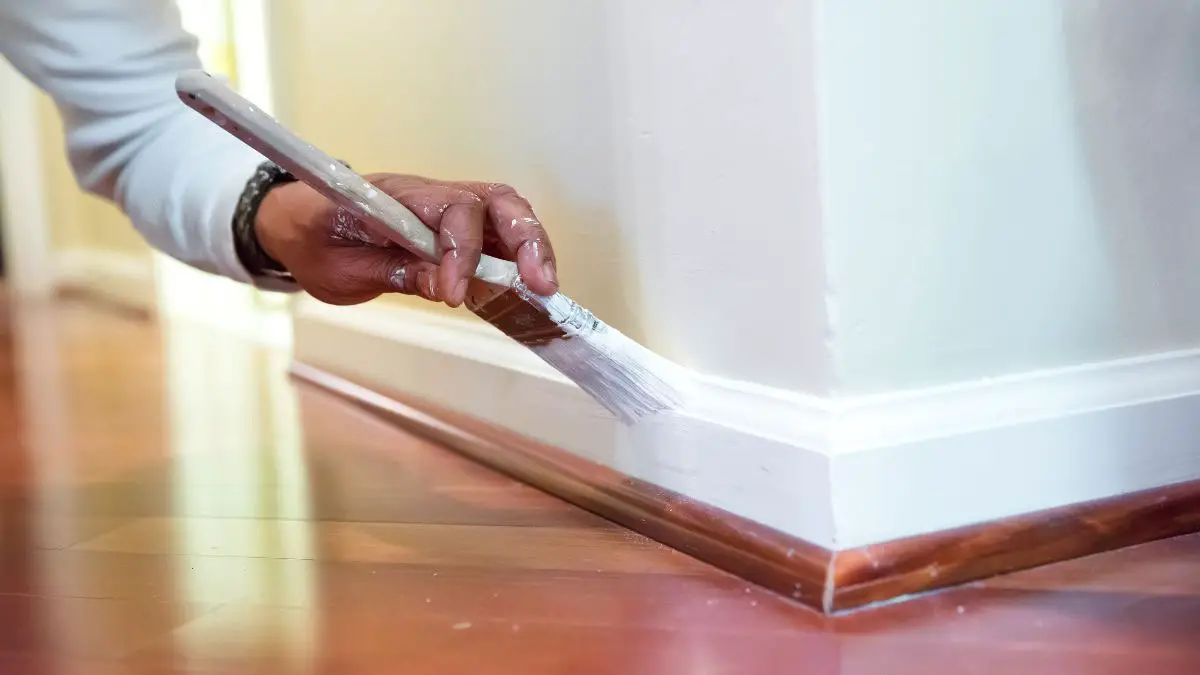Are you considering painting your baseboards? If so, you’re not alone! But you’re probably wondering, “What is the best paint for my baseboard?”. In this beginner’s guide, we’ll go over everything you need to know about paints and finishes for baseboards so that you can make the best decision for your home. Before starting, we’ll go over the types of paint, color, sheens, and prep work. Alright, let’s get started!
What Are Baseboards?
Baseboards are the trim that is installed at the bottom of your walls. They serve two primary purposes: to protect your walls from scuffs and scratches and to give your home a more finished look. As far as materials go, they come in wood, plastic, or metal!
Why Do You Need Baseboards?
Baseboards are essential for protecting your walls from damage. No matter how careful you are, it’s inevitable that your furniture will bump into your walls from time to time. Without baseboards in place, those bumps will cause scuffs and scratches on your paint or wallpaper. Over time, those scratches will become more visible, making your room look messy and unkempt.
In addition to protecting your walls, baseboards give your home a finished look. They cover the gap between the wall and the floor, creating a clean line and making your room look more polished.
Why Paint Baseboards?
When baseboards are left unpainted, they can become scuffed and scratched, which will eventually lead to damage to your walls. Additionally, paint provides protection against water damage, which is especially important in kitchens and bathrooms.
Painting baseboards can make a room feel new again and is also an inexpensive way to update the look of your home. Plus, it’s an easy project that most homeowners can tackle themselves.
The Best Paint for Your Baseboards
Baseboards are typically made from wood, plastic, or metal. For wooden baseboards, you’ll want to use latex paint. Latex paint is easy to work with and provides good coverage. It will also protect your wood from moisture damage.
If your baseboards are made from plastic or metal, you can use either latex or oil-based paint. Again, latex paint is easy to work with and will still provide good coverage, while oil-based paint is more durable and will resist scratches and scuffs.
Latex Paint
The easiest type of paint to work with is latex paint. It’s water-based, so it’s easy to clean up if you make a mistake. Latex paint also provides good coverage and dries quickly.
For dark-colored baseboards, you may need to use a primer before painting with latex paint. This will help the paint adhere to the surface and prevent the dark color from bleeding.
Oil-Based Paint
Oil-based paint is more durable than latex paint and will resist scratches and scuffs. It’s also less likely to chip or peel over time. However, oil-based paint is more difficult to work with than latex paint. In addition, it has a strong odor and can be messy to clean up.
If you’re painting over a light color, you likely won’t need to use a coat of primer. But, if you’re painting over a dark color, you’ll need to use a primer to prevent the dark color from bleeding through.
What Sheen of Paint is Best for Baseboards?
The sheen of paint refers to the amount of light reflected off the surface. Paint with a high sheen will reflect more light, while painting with a low sheen will reflect less light.
For baseboards, we recommend using paint with a semi-gloss or high-gloss sheen since these are easy to clean and resist scratches and scuffs.
What Color Should We Paint Our Baseboards?
The color you paint your baseboards will depend on the overall style of your home. If you have a traditional home, white is always a safe choice. However, try painting your baseboards in bold colors that contrast with your walls for a more modern look.
How Do We Prep the Baseboards for Painting?
Before you start painting, it’s essential to prep your baseboards. You’ll first want to vacuum the area with a soft brush attachment to remove any dust or dirt. Next, take a damp cloth and wipe down the baseboards thoroughly.
If your baseboards are particularly dirty or have grease stains, you may need a mild cleaner and scrub brush to remove the dirt. Once your baseboards are clean, make sure they’re completely dry before you start painting.
Frequently Asked Questions
Q: Is it better to use water-based or oil-based paint?
A: Water-based paints, also known as latex paints, are easier to work with and provide good coverage. They’re also easier to use and clean up. Oil-based paints are more durable and will resist scratches and scuffs. They also offer the best-looking finish, so if you don’t mind strong odor, cost, and convenience, go oil-based.
Q: Can I use a flat or matte sheen on baseboards?
A: We don’t recommend using flat or matte sheens on baseboards because they’re more challenging to clean.
Q: How do I remove old paint from my baseboards?
A: If your baseboards are painted with latex paint, you can use a putty knife to remove the paint. For oil-based paints, you’ll need to use a paint stripper.
Final Thoughts
Picking the best paint for your baseboards is important if you want them to look good and last long. Latex paint (or water-based paint) is easy to work with but may require a primer if you paint over a dark color. Oil-based paint is more durable but can be messy to work with. For the best results, we recommend using semi-gloss or high-gloss paint in a color that contrasts with your walls. Preparing your baseboards before painting is also important for the best results. Be sure to vacuum and clean them before painting, and ensure they’re completely dry. If you have any questions, feel free to ask in the comments below!

